Home>Gardening & Outdoor>Landscaping Ideas>How To Get Rid Of Gnats In Grass


Landscaping Ideas
How To Get Rid Of Gnats In Grass
Published: January 24, 2024
Learn effective landscaping ideas to get rid of gnats in grass and enjoy a gnat-free outdoor space. Discover practical tips and solutions for a gnat-free lawn.
(Many of the links in this article redirect to a specific reviewed product. Your purchase of these products through affiliate links helps to generate commission for Storables.com, at no extra cost. Learn more)
Introduction
Welcome to the ultimate guide on how to get rid of gnats in grass. Gnats, also known as fungus gnats, are tiny flying insects that can quickly become a nuisance in your lawn or garden. These pesky creatures thrive in moist environments and are often attracted to decaying organic matter, making your lush green grass an ideal breeding ground. Not only can a gnat infestation be bothersome, but it can also cause damage to the roots of your grass and other plants, leading to wilting and poor growth.
In this comprehensive guide, we will explore effective methods to identify, eliminate, and prevent gnat infestations in your grass. Whether you prefer natural remedies or chemical solutions, we’ve got you covered. By the end of this article, you’ll be equipped with the knowledge and tools to reclaim your grass and enjoy a gnat-free outdoor space.
Key Takeaways:
- Combat gnat infestations in grass using natural remedies like neem oil and beneficial nematodes, or chemical solutions such as insecticidal soaps and larvicides. Prevent future outbreaks by regulating soil moisture and removing organic debris.
- Identify, eliminate, and prevent gnat infestations in your lawn to reclaim its health and beauty. Use a holistic approach with natural and chemical solutions, alongside proactive measures, for lasting results and a gnat-free outdoor space.
Read more: How To Get Rid Of Gnats In Sink
Identifying the Gnats
Before embarking on the journey to eradicate gnats from your grass, it’s crucial to accurately identify these tiny pests. Fungus gnats are small, delicate insects with long legs and a slender, grayish-black body. They are typically around 1/8 inch in length and have a distinctive Y-shaped pattern on their wings, making them easily recognizable.
One of the most common signs of a gnat infestation in grass is the presence of adult gnats hovering above the grass or swarming around nearby plants. Additionally, you may notice the emergence of small, dark larvae in the soil, especially in areas with excessive moisture. These larvae feed on organic matter, including the roots of grass and other plants, which can lead to wilting and yellowing of the foliage.
Another telltale sign of gnat infestation is the presence of tiny, black specks on the surface of the soil, indicating the presence of adult gnats or their larvae. If you observe these signs in your lawn or garden, it’s essential to take prompt action to prevent the infestation from worsening and causing further damage.
By accurately identifying the presence of gnats in your grass, you can effectively tailor your approach to eliminating them and preventing future infestations. In the following sections, we will delve into natural and chemical solutions to combat gnat infestations, empowering you to reclaim the health and vitality of your grass.
Natural Remedies for Getting Rid of Gnats in Grass
When it comes to combating gnat infestations in grass, natural remedies offer effective and eco-friendly solutions that are safe for your lawn, family, and the environment. Here are some natural methods to eliminate gnats from your grass:
- Neem Oil: Derived from the seeds of the neem tree, neem oil is a potent natural insecticide that can effectively control gnat populations. Dilute neem oil in water and spray it onto the affected areas of your grass to target both adult gnats and their larvae.
- Diatomaceous Earth: This fine powder, composed of the fossilized remains of diatoms, is a natural and non-toxic solution for eradicating gnats. Sprinkle diatomaceous earth over the infested areas of your grass to dehydrate and eliminate the gnats upon contact.
- Beneficial Nematodes: Introducing beneficial nematodes, microscopic roundworms that are natural predators of fungus gnat larvae, into the soil can help control gnat populations. These beneficial organisms actively seek out and feed on the larvae, effectively reducing the gnat infestation in your grass.
- Sticky Traps: Deploying yellow sticky traps in your lawn or garden can help capture adult gnats, reducing their numbers and preventing further reproduction. Place the traps strategically in areas where gnat activity is prevalent to intercept and control the population.
- Aeration and Drainage: Improving the aeration and drainage of your lawn can create an inhospitable environment for gnats. By enhancing soil drainage and reducing excess moisture, you can discourage gnat breeding and limit their presence in your grass.
By leveraging these natural remedies, you can effectively combat gnat infestations in your grass while maintaining a healthy and sustainable outdoor environment. These methods offer a gentle yet powerful approach to addressing gnat problems, allowing you to restore the vibrancy of your grass without resorting to harsh chemicals.
One tip for getting rid of gnats in grass is to remove any standing water or wet areas in the yard, as gnats are attracted to moisture. This can help reduce their breeding grounds and population.
Chemical Solutions for Eliminating Gnats in Grass
While natural remedies provide eco-friendly alternatives for managing gnat infestations, chemical solutions can offer rapid and targeted control of these persistent pests. When implementing chemical treatments, it’s essential to prioritize safety and carefully follow the instructions provided by the product manufacturers. Here are some effective chemical solutions for eliminating gnats in grass:
- Insecticidal Soaps: Formulated with natural fatty acids, insecticidal soaps can effectively target and eliminate adult gnats on contact. These soaps disrupt the cellular membranes of the insects, leading to their demise while posing minimal risk to beneficial organisms and the environment.
- Botanical Pyrethrins: Derived from chrysanthemum flowers, botanical pyrethrins are natural insecticides that can swiftly control gnat populations. These compounds act on the nervous systems of gnats and other insects, providing rapid knockdown effects while degrading quickly in the environment.
- Larvicides: Specifically designed to target gnat larvae in the soil, larvicides can effectively disrupt the development and reproduction of gnats. These products contain active ingredients that penetrate the soil and inhibit the growth and survival of gnat larvae, reducing their numbers over time.
- Microbial Insecticides: Utilizing naturally occurring microorganisms such as Bacillus thuringiensis (Bt), microbial insecticides offer a targeted approach to controlling gnat larvae. When applied to the soil, these microbial agents infect and kill the larvae, providing a sustainable and selective method of gnat management.
- Growth Regulators: By interfering with the growth and development of gnat larvae, growth regulators can disrupt the life cycle of gnats, preventing them from maturing into reproductive adults. These products offer long-term control by impeding the ability of gnats to reproduce and perpetuate the infestation.
When considering chemical solutions for gnat control, it’s important to assess the specific needs of your lawn and the severity of the infestation. Additionally, exercising caution and adhering to safety guidelines is paramount to safeguarding the well-being of your grass, other plants, and the surrounding ecosystem.
By integrating these chemical solutions judiciously and responsibly, you can effectively address gnat infestations in your grass while minimizing the impact on the environment and promoting the health of your outdoor space.
Preventing Future Gnat Infestations in Grass
After successfully addressing a gnat infestation in your grass, it’s crucial to implement preventive measures to mitigate the risk of future outbreaks. By adopting proactive strategies and maintaining a vigilant approach, you can create an environment that is inhospitable to gnats, safeguarding the health and vitality of your grass. Here are effective methods for preventing future gnat infestations:
- Maintain Optimal Soil Moisture: Gnats thrive in moist environments, making it essential to regulate soil moisture levels in your lawn. Avoid overwatering and ensure proper drainage to prevent the accumulation of excess moisture, which can attract and sustain gnat populations.
- Remove Decaying Organic Matter: Regularly clear away decaying leaves, grass clippings, and other organic debris from your lawn to eliminate potential breeding sites for gnats. By minimizing the availability of organic matter, you can disrupt the gnat life cycle and reduce their reproductive opportunities.
- Monitor and Manage Plant Health: Healthy plants are more resilient to gnat infestations, so prioritize the well-being of your grass and other vegetation. Address any signs of stress or disease promptly, as weakened plants are more susceptible to gnat damage and infestation.
- Implement Natural Predators: Introduce beneficial insects and organisms that prey on gnats, such as predatory mites or rove beetles, to help control gnat populations naturally. These natural predators can play a valuable role in maintaining ecological balance and minimizing gnat infestations.
- Utilize Physical Barriers: Install barriers such as floating row covers or mesh netting to protect vulnerable plants from gnat infestations. These physical barriers can prevent adult gnats from laying eggs near the roots of your grass, reducing the likelihood of larval infestation.
By incorporating these preventive measures into your lawn care routine, you can fortify your grass against future gnat infestations while promoting a thriving and resilient outdoor environment. Consistent monitoring and proactive management will help you sustain a gnat-free lawn and enjoy the beauty of your grass without the disruption caused by these persistent pests.
Read more: How To Get Rid Of Gnats On Porch
Conclusion
Congratulations! You’ve now gained valuable insights into the world of gnat infestations in grass and learned effective strategies for identifying, eliminating, and preventing these pesky pests. By understanding the characteristics of gnats and their impact on your lawn, you’re empowered to take proactive steps to reclaim the health and beauty of your grass.
Whether you opt for natural remedies or chemical solutions, the key lies in addressing gnat infestations promptly and decisively. Natural remedies, such as neem oil and beneficial nematodes, offer gentle yet potent means of controlling gnats while maintaining a harmonious outdoor environment. On the other hand, chemical solutions, including insecticidal soaps and larvicides, provide targeted control when applied responsibly and in accordance with safety guidelines.
Furthermore, by implementing preventive measures such as regulating soil moisture, removing organic debris, and fostering plant health, you can fortify your grass against future gnat infestations. These proactive strategies contribute to the long-term resilience of your lawn and minimize the risk of gnat-related disruptions.
As you embark on your journey to combat gnat infestations in your grass, remember that a holistic approach, encompassing both natural and chemical solutions, alongside preventive measures, is key to achieving sustainable and lasting results. By integrating these strategies into your lawn care routine, you can cultivate a gnat-free environment that fosters the flourishing growth of your grass and enhances the overall beauty of your outdoor space.
Armed with this knowledge, you’re well-equipped to tackle gnat infestations with confidence and safeguard the well-being of your grass, allowing you to revel in the tranquility and splendor of your gnat-free lawn.
Frequently Asked Questions about How To Get Rid Of Gnats In Grass
Was this page helpful?
At Storables.com, we guarantee accurate and reliable information. Our content, validated by Expert Board Contributors, is crafted following stringent Editorial Policies. We're committed to providing you with well-researched, expert-backed insights for all your informational needs.















0 thoughts on “How To Get Rid Of Gnats In Grass”